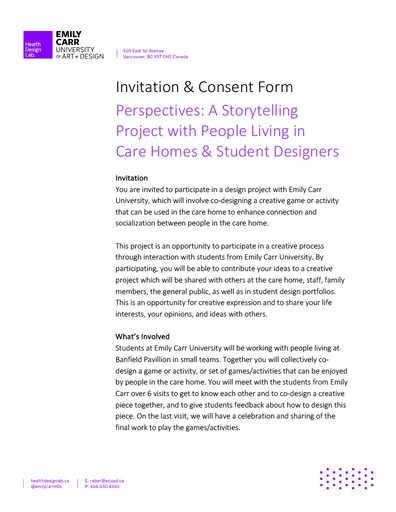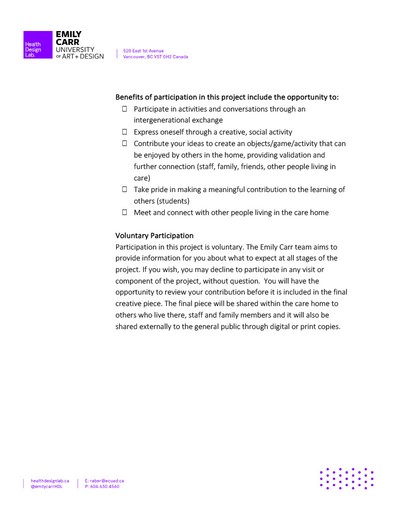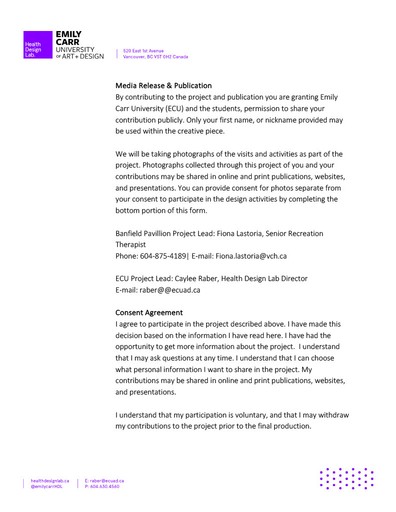Craft n' Connect
Co-designing dementia-friendly gameplay
Industry: Healthcare, Dementia Care, Health & Wellness

Designing a playable game for long-term care home residents living with dementia, using co-design methodology.
✦
Role:
I worked on this project as the primary researcher, helping shape the design and development of the game and gameplay. I was responsible for workshop facilitation, user testing, illustration, and content writing.
✦
Achievements:
Our game was selected to be exhibited in Emily Carr University’s Health Design Lab Showcase in April 2024 as part of the Perspectives Program, before being moved back to Banfield Pavilion to continue being played.
Deliverable(s)
Physical Game Prototype
Organisation:
Banfield Pavilion, Vancouver Coastal Health
Timeline:
January - April 2024, 4 months
Team:
Overview
Working alongside residents with dementia to collectively design a functional game to enhance connection and socialization through its use by residents, staff, volunteers, family and visitors.
My Role
I led the research for Craft n' Connect, including; user research, planning and facilitating workshops, and UX writing, along with the illustrations for the game box. This project was made alongside Jasmine Wong, who did all of the graphic design and print layout, and Sunnie Sun, who worked on the fabrication of the physical game prototypes and final.
Problem
Social connection is essential in long-term care homes.
How might we design an inclusive game experience to enhance connection and socialization for those living in long-term care home facilities?
How might participatory design support the creation of a meaningful, inclusive game, enhancing connection and socialisation for residents in long-term dementia care?
Goals:
Explore how physical forms influence spatial reasoning in children
Translate historical design methods into playful, research-backed learning tools
How can basic block play be designed to support the development of children's spatial concepts (e.g., size, direction, proximity)?
Inspired by a study in Mind, Brain and Education, which links block play to stronger spatial reasoning skills, I set out to create a form of interactive sculpture that could serve as both a playful experience and a cognitive learning tool.
Consent
Working with care staff to explain the project scope and obtain signed consent from residents.
Before our first visit to Banfield Pavilion, we began with familiarising ourselves with consent procedures and having consent forms for our resident co-designers to sign.
These consent forms covered details such as usage of residents’ names, work, and details, in our projects and for publishing.
Residents were explained the scope of our project and terms in the forms by staff and caregivers before providing signed consent.
How can basic block play be designed to support the development of children's spatial concepts (e.g., size, direction, proximity)?
Inspired by a study in Mind, Brain and Education, which links block play to stronger spatial reasoning skills, I set out to create a form of interactive sculpture that could serve as both a playful experience and a cognitive learning tool.
Co-Designers
Long-term memory is often stronger than short term memory in older adults with dementia.
Initial sessions were focused on introductions and memory-based activities. Given our co-designers' experience with dementia, we prioritized long-term memory through storytelling: hometowns, hobbies, careers.
Long-term memory is often stronger than short term memory in older adults with dementia.
Using storytelling-based icebreakers, we learned about our co-designer residents’ backgrounds.
Key Insight: Activities that encouraged simple tactile engagement and verbal communication were most successful.
We then introduced a variety of games and activities — including Uno, Picture Bingo, Playdoh, and charades — to observe preferences and group dynamics.





Inspiration
Design in Space is a physical play prototype designed to support the development of children's spatial awareness.
Design References:
Alma Siedhoff-Buscher: Bauhaus designer known for block-based toys using primary colors and simple geometry. Her minimalist block designs and use of primary colors informed the visual language of my project. The simplicity invites exploration without overwhelming young users.
Amedee Ozenfant: Cubist painter whose vase forms inspired overall composition; informed larger structure of the final piece. His vase compositions inspired the larger, sculptural form—bringing cohesion and artistic structure to the final arrangement.
Together, these influences bridged early 20th-century design thinking with modern developmental psychology.
Methodology
Design in Space is a physical play prototype designed to support the development of children's spatial awareness.
User Research Framing (Implicit):
Developmental psychology insights on play and cognition
Indirect observational design: Designed with user (children) behavior in mind, even without direct user testing
Design Strategy:
Start with user needs: hands-on interaction, balance, tactile feedback
Reduce complexity: use geometric shapes and strong color contrast to increase cognitive clarity
Prototyping
Design in Space is a physical play prototype designed to support the development of children's spatial awareness.
Initial Plan: Carve wooden blocks (abandoned due to feasibility)
Originally envisioned in wood, but due to fabrication constraints, I pivoted to using sponges—lightweight, malleable, and safe for children.
I cut the sponges into modular block forms, reinforced them with cardstock for structural integrity, then painted them with acrylics in red, blue, green, and white.Solution: Fabricated modular block system using sponge and cardstock
Build Process:
Cut sponge shapes into interlocking pieces
Reinforced with cardstock to maintain structure
Painted in Bauhaus-inspired palette (red, blue, green, white)
Adjusted block forms to ensure balance and stackability
Materials & Prototyping
Originally envisioned in wood, but due to fabrication constraints, I pivoted to using sponges—lightweight, malleable, and safe for children.
I cut the sponges into modular block forms, reinforced them with cardstock for structural integrity, then painted them with acrylics in red, blue, green, and white.
Shape Testing
Each block was adjusted to ensure it could stand independently, balance when stacked, and invite rearrangement.
This iterative shaping process ensured the final design supported open-ended play—crucial for spatial exploration.
Build Process:
Cut sponge shapes into interlocking pieces
Reinforced with cardstock to maintain structure
Painted in Bauhaus-inspired palette (red, blue, green, white)
Adjusted block forms to ensure balance and stackability
Build Process:
Cut sponge shapes into interlocking pieces
Reinforced with cardstock to maintain structure
Painted in Bauhaus-inspired palette (red, blue, green, white)
Adjusted block forms to ensure balance and stackability




Design
Design in Space is a physical play prototype designed to support the development of children's spatial awareness.
Colors: Primary palette chosen to align with cognitive development stages and Bauhaus inspiration
Shapes: Simple, abstracted, inspired by both Bauhaus blocks and cubist vase forms
Structure: Built to encourage open-ended play—blocks can be reassembled in multiple configurations

Outcome
Design in Space is a physical play prototype designed to support the development of children's spatial awareness.
5. Outcome
The final piece is a set of vibrant, sculptural blocks that serve as both a visual art object and a developmental tool. It encourages young users to think spatially, experiment physically, and play curiously—interacting with form, balance, and structure in real time.



Reflections
Special thanks to our co-designers: Cat, Jiren, and Robert. This project wouldn’t exist without their stories, input, creativity, and collaboration.
Craft n' Connect reinforced the importance of accessibility, flexibility, and storytelling in the design of playful tools for health. Co-designing with individuals living with dementia taught me how to adapt communication and prioritize inclusivity over aesthetics—an invaluable lesson for any designer.
Relevance
Design in Space is a physical play prototype designed to support the development of children's spatial awareness.
Relevance to Games User Research
Spatial Learning in Games: Spatial reasoning is key in many game mechanics—from puzzle-solving to navigation
Physical-to-Digital Translation: Shows understanding of how physical prototypes inform digital design
User-Centered Design: Embeds user psychology into every design choice, even without digital interaction
Relevance to Games User Research
Highlights the intersection of cognitive psychology and game mechanics
Demonstrates how physical prototyping can serve as a precursor to interactive game design
Emphasizes the importance of user empathy and iterative testing—even in early, analog form
© 2025 Neharika Sidda
Made with ♡ in Vancouver, BC



